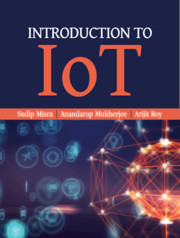1 - Basics of Networking
Published online by Cambridge University Press: 09 January 2021
Summary
Learning Outcomes
After reading this chapter, the reader will be able to:
Understand the basic principles of computer networking
List the basic terminologies and technologies
Relate new concepts of IoT with the basics of networking
Discuss various network configurations and topologies
Explain various OSI (open systems interconnections) and TCP/IP (transmission control protocol/Internet protocol) layers and their associated uses
Describe basics of network addressing
Introduction
In the present era of data- and information-centric operations, everything—right from agriculture to military operations—relies heavily on information. The quality of any particular information is as good as the variety and strength of the data that generates this information. Additionally, the speed at which data is updated to all members of a team (which may be a group of individuals, an organization, or a country) dictates the advantage that the team has over others in generating useful information from the gathered data. Considering the present-day global scale of operations of various organizations or militaries of various countries, the speed and nature of germane information are crucial for maintaining an edge over others in the same area. To sum it up, today's world relies heavily on data and networking, which allows for the instant availability of information from anywhere on the earth at any moment.
Typically, networking refers to the linking of computers and communication network devices (also referred to as hosts), which interconnect through a network (Internet or Intranet) and are separated by unique device identifiers (Internet protocol, IP addresses and media access control, MAC addresses). These hosts may be connected by a single path or through multiple paths for sending and receiving data. The data transferred between the hosts may be text, images, or videos, which are typically in the form of binary bit streams [1].
Points to ponder
The data generated from a camera sensor tells us more about a scene compared to the data generated from, say, a proximity sensor, which only detects the presence of people in its sensing range.
Furthermore, the simultaneous data generated from multiple cameras focusing on the same spot from various angles tell us even more about the scene than a single camera focused at that scene.
- Type
- Chapter
- Information
- Introduction to IoT , pp. 3 - 24Publisher: Cambridge University PressPrint publication year: 2021

